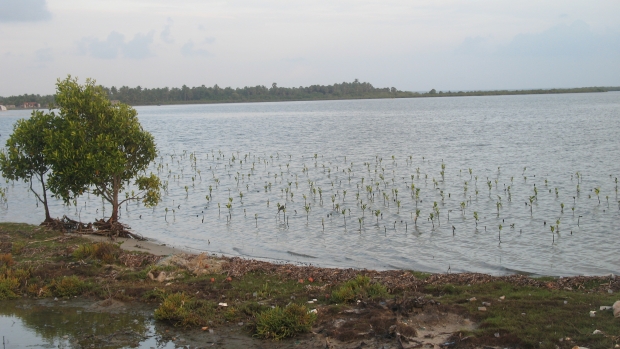Grants :: Small Grant Facilities :: Community-based mangrove planting at Kurakkanhena
Community-based mangrove planting at Kurakkanhena

Community based mangrove planting at Kurakkanhena, Sri Lanka © KEkaratne , 2009
Objectives
This project had four objectives:
- to enhance awareness of the value of mangroves;
- to demonstrate approaches to successful mangrove restoration;
- to prevent further destruction of mangroves; and
- to develop alternative livelihoods.
Background
Puttalam lagoon on Sri Lanka’s north-west coast is noted nationally for its high biodiversity. The lagoon encompasses about 600 hectares of mangroves, 700 hectares of salt marshes, extensive mud flats, seagrass beds, and the estuaries of two rivers, the Kala Oya and Mee Oya.
The village of Kurakkanhena lies on the northern side of the lagoon. Like other communities living around the lagoon, the main livelihood of Kurakkanhena is fishing. This is now threatened by degradation of the rich mangrove stands bordering the lagoon caused by population growth, economic development and a general lack of environmental awareness.
Around 100 families in the area cut mangroves for the firewood trade, for fuelwood, and to clear land for prawn culture. This pressure on the ecosystem has affected its biodiversity and productivity – fish populations have declined dramatically, reducing catches and fishing incomes. Limited awareness of the value of mangroves and a lack of community involvement have made this trend difficult to reverse, creating an urgent need for interventions to rehabilitate degraded mangrove forests and institute proper community-based management.
A leading local fishery society, the Semuthu Fisheries Cooperative Society Ltd, secured a small grant from MFF to restore the dwindling mangrove vegetation around part of the lagoon, educate local people and schoolchildren on the value of mangroves, and develop alternative livelihoods. Project activities were implemented in partnership with the St Mary’s Fisheries Cooperative Society of Kurakkanhena.
Target beneficiaries
Fisher families in Kurakkanhena village.
Outputs
- Training for community members in nursery establishment and management.
- Establishment and management of seven community-based mangrove nurseries.
- Implementation of a community-based mangrove replanting campaign.
- Planting of 10,000 mangrove propagules on a 0.4-hectare plot, and fencing of the plot.
- Delivery of awareness programmes for schoolchildren and community members.
- Production of brochures on mangroves in the Sinhala and Tamil languages.
- Provision of fuel-efficient firewood-gas stoves to 30 families.
Accomplishments and challenges
The project selected appropriate species and sites for replanting after assessing the existing natural vegetation in the area. It established seven mangrove nurseries, and provided seeds and other necessary materials and equipment. The mangrove planting was carried out with species such as Rhizophora spp., Avicennia spp., Excoecaria agallocha and Lumnitzera racemosa. Community members took part in the replanting campaign and helped to fence off the planted area to protect it from grazing animals.
Members of St Mary’s Fisheries Cooperative Society who took part in project activities acquired a high level of competence in mangrove nursery maintenance. The Kurakkanhena Fisheries Society asked for the district forest officer to act as guardian of the Kurignanpitiya mangrove forest, which the community helped restore.
The project conducted awareness programmes for schoolchildren and members of St Mary’s Fisheries Cooperative Society on the importance of mangroves and mangrove fauna. Nearly 400 students from three schools, and 65 members of the Cooperative Society, participated in these activities, auguring well for future sustainability.
The project also supplied fuel-efficient firewood-gas stoves to 30 families to encourage them to reduce the amount of wood they cut from mangroves. These stoves helped to reduce the consumption of firewood, and also increased awareness of the threats to mangroves among project beneficiaries.
Challenges
The challenges faced by the project included a lack of information on mangrove restoration techniques, poor weather during the planting programme, and an inadequate amount of time to tend the planting until it was properly established. However, a five-member committee was formed to tend the replanted plot under the support and guidance of the Marine and Coastal Resources Conservation Foundation (MCRCF), a local NGO.
Contributions to cross-cutting themes
Communications
Mangrove awareness brochures in the Sinhala and Tamil languages were produced with support from MCRCF and disseminated to schoolchildren and community members.
Lessons Learned
Since changing weather conditions can have an impact on tree growth and undermine replanting efforts, it is important to build flexibility into the project schedule from the outset. Donors should consider this constraint when disbursing funds. Projects of this nature should also last for at least 18 months if they are to have appreciable results.
Future projects should aim to build knowledge and experience of working with mangrove species other than Rhizophora and Bruguiera, and to that end should promote a dialogue between practitioners and scientists.
Project Facts
Country
Location
Puttalam, Sri Lanka
Topic
Duration
1st Feb 2009 to 31st Oct 2009
MFF Grant Amount
US$4,232
Implementing Partner
Mr H. S. Amarasekera
Consultant
Semuthu Fisheries Cooperative
Society Ltd,
Puttalam, Sri Lanka
Tel: +94 77 2263365
“The fuel-efficient stoves provided through the project enabled us to cut our fuelwood usage by 40% to 50%.”
— Ms G. SUBASHINI FERNANDO
PROJECT BENEFICIARY
